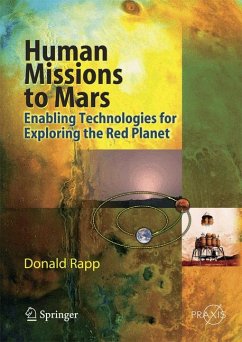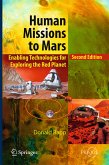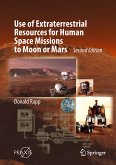For any human mission to the Red Planet the possible utilization of any resources indigenous to Mars would be of great value and such possibilities are discussed in Chapter 5. The use of indigenous resources on the Moon is described as a precursor to the availability of similar resources on Mars and issues such as fuelling Mars-bound craft from lunar resources, the use of lunar ferries, staging, assembly and refueling in near-Earth space are all discussed. The important applications arising from the transportation of hydrogen to Mars are also described. Chapter 6 deals with a range of previous Mars mission studies and the technologies they employed. Chapter 7 looks as how NASA is planning for its return to the Moon, and the use of the Moon as a stepping stoneto Mars. Chapter 8 presents the author's detailed analysis of why, in his opinion, the current NASA approach will fail to send humans to Mars before 2080. The book concludes with three appendices describing the use of solar energy on the Moon and on Mars and the value of indigenous water on Mars.
Dieser Download kann aus rechtlichen Gründen nur mit Rechnungsadresse in A, B, BG, CY, CZ, D, DK, EW, E, FIN, F, GR, HR, H, IRL, I, LT, L, LR, M, NL, PL, P, R, S, SLO, SK ausgeliefert werden.
"A skeptic's view on the realities of sending a human mission to Mars in the 21st century. ... Human Missions to Mars is hardbound, and Rapp's use of supporting formula, graphs, and technical illustrations ... make it clear that this volume is meant to be used as a reference book in research institutions, technical libraries, and scientific organizations. However, Rapp's engaging writing style and pragmatic view on this subject also makes it an interesting read for the armchair Mars explorer ... ." (Anthony Young, The Space Review, March, 2008)
"This book looks at human missions to Mars from an engineering perspective. ... The book includes appendices describing the use of solar energy on the Moon and on Mars and the value of indigenous water on Mars. This book was written for space scientists and engineers, intermediate-level undergraduates, and postgraduate researchers studying every aspect of human missions to Mars." (The Lunar and Planetary Information Bulletin, 2008)
"Rapp's book is a very readable, critical view of possible explorations of Mars. ... The book discusses in detail the many technologies that must be developed and demonstrated before a successful human mission to Mars can occur. ... The appendixes give significant details about solar energy and water on Earth's moon and Mars. The work is an excellent analysis of the difficulties posed by a human mission to mars. ... Summing Up: Recommended. Upper-division undergraduate through professional collections." (D. B. Mason, CHOICE, Vol. 45 (9), 2008)
"In this book, Donald Rapp ... sets out to provide a critical assessment of the requirements for human missions to Mars from an engineering perspective. ... I found it informative because I learned a lot about the intricacies of Mars mission architectures and the inherent engineering challenges. ... it is refreshing to read a detailed and independent study by someone who has no vestedinterest in any 'official' plans for human space missions." (Ian Crawford, Eos, Vol. 89 (36), 2008)









